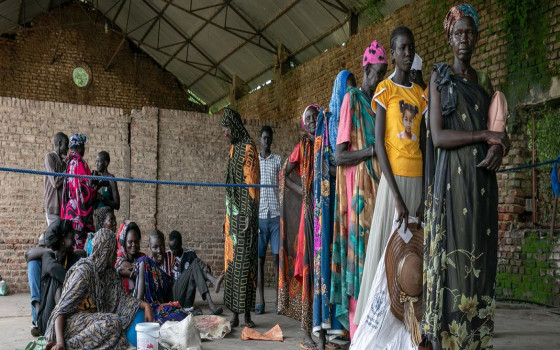Nearly 300 million people suffered from acute hunger last year, especially in Yemen, Gaza, and Sudan.

- Europe and Arabs
- Saturday , 17 May 2025 6:45 AM GMT
Capitals: Europe and the Arab World
Severe food insecurity and child malnutrition exacerbated the suffering of millions of people in some of the world's most vulnerable regions for the sixth consecutive year in 2024. According to the Global Report on Food Crises, conflicts, economic shocks, extreme climate events, and forced displacement continued to drive food insecurity and malnutrition worldwide, leaving disastrous impacts on many already fragile regions. According to the UN daily news bulletin, a copy of which we received this morning, it added, "In 2024, more than 295 million people in 53 countries and territories experienced acute levels of hunger—an increase of 13.7 million people from 2023. Of grave concern is the worsening prevalence of acute food insecurity, which now stands at 22.6 percent of the assessed population. This marks the fifth consecutive year that this figure has remained above 20 percent.
Gaza, Sudan, and Yemen
The number of people facing catastrophic hunger (famine)—which is Phase 5 of the Integrated Food Security Phase Classification—more than doubled during the same period, reaching 1.9 million people—the highest level recorded since the Global Report on Food Crises began monitoring in 2016.
Malnutrition, particularly among children, reached extremely high levels, including in the Gaza Strip, Mali, Sudan, and Yemen. Nearly 38 million children under the age of five suffered from acute malnutrition. In 26 food crises.
The report also highlights a sharp increase in hunger caused by forced displacement, with nearly 95 million forcibly displaced people—including internally displaced people, asylum seekers, and refugees—living in countries facing food crises such as the Democratic Republic of the Congo, Colombia, Sudan, and Syria, out of a global total of 128 million forcibly displaced people.
Humanitarian Funding Cuts
UN Secretary-General António Guterres said this global report on food crises is “another indictment of a world dangerously off track. Long-standing crises are now being exacerbated by a newer crisis: a dramatic decline in life-saving humanitarian funding to respond to these needs. This is more than just a failure of systems—it is a failure of humanity. Hunger in the 21st century is untenable. We cannot respond to empty stomachs with empty hands and indifference.
Key Causes
According to the report, conflict remained the primary driver of acute food insecurity, affecting some 140 million people across 20 countries and territories. Famine has been confirmed in Sudan, while other hotspots where people are experiencing catastrophic levels of acute food insecurity include the Gaza Strip, South Sudan, Haiti, and Mali.
Other factors include economic shocks, including inflation and currency depreciation. Some of the largest and most prolonged food crises have been driven primarily by economic shocks, including in Afghanistan, South Sudan, Syria, and Yemen. These include extreme weather events, particularly droughts and floods caused by the El Niño phenomenon.
According to the Global Report on Food Crises forecasts, hunger shocks are likely to continue through 2025, with the global network predicting the largest decline in humanitarian funding for food and nutrition crises in the report's history.
A bold call to break the cycle of food crises
Rates of acute food insecurity and malnutrition have risen to record levels, but global funding is experiencing a faster decline. It has been declining for years, and political momentum is waning.
The report emphasizes that breaking the cycle of worsening hunger and malnutrition requires bold steps that prioritize evidence-based, impact-driven actions. This means pooling resources, scaling up what works, and putting the needs and voices of affected communities at the center of every response.
In addition to emergency assistance, the Global Network Against Food Crises recommends investing in local food systems and integrated nutrition services to address long-term vulnerabilities and build resilience to shocks—especially in crisis-prone areas where 70 percent of rural households depend on agriculture for their livelihoods and food.
About the Global Report
The Global Report on Food Crises is published annually by the Global Network Against Food Crises, drawing on analysis from the Food Security Information Network, an international coalition of UN, EU, and governmental and non-governmental agencies working together to address food crises.
It is a unique platform that brings together key operational agencies, international financial institutions, member states, and organizations that collectively strive to reduce and end hunger through evidence-based actions proven to make a difference.














No Comments Found